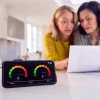Ofcom Enhances UK Code of Practice for Broadband ISP Speeds
Consumers will soon benefit from more accurate information on what broadband line speeds they can expect from their ISP and what they can do if this isn’t delivered. The changes form part of a proposed update to Ofcom’s voluntary code of practice for residential speeds.
At present most of the UK’s major ISPs have already signed up to the regulator’s existing 2015 Broadband Speed Code of Practice, which among other things requires providers to explain to new customers the access line speed that they’re likely to achieve at home, and to try to resolve any problems when speeds fall significantly below the estimate. A similar code exists for business connections (here).
As part of this, consumers should also be given a personal estimate of download speed during the sign-up process with a new ISP, which reflects the 20th and 80th percentile speeds to be provided (i.e. an estimate range of possible performance for your line). See our example from Vodafone below.
Advertisement

Providers also have to set a Minimum Guaranteed Access Line Speed (MGALS) for your line, which reflects the slowest 10% of similar users and is available upon request. This is important because ISPs that fail to resolve any significant speed problems may offer customers the right to downgrade or even to exit your contract, without penalty, if their performance falls below the MGALS for your connection.
Ofcom’s existing code is largely focused on connection technologies where performance may be distinctly less reliable, such as copper line ADSL and hybrid-fibre FTTC (VDSL2) based services that often suffer flaky performance due to poor quality home wiring, external interference, damage or long copper lines (weaker signals over distance) etc.
However cable (DOCSIS) providers (e.g. Virgin Media) and some “full fibre” ISPs (e.g. Hyperoptic), which are generally much more reliable performers, are also members of the code even through strictly speaking they don’t have to be. Sadly most smaller ISPs have not joined the code and thus related consumers won’t benefit from its protection.
Advertisement
The Changes for 2017
Ofcom are now proposing to make a few tweaks to their code, such as by updating the required personal speed estimates to reflect the impact of network contention and ensuring that customers have better information about their right to exit a contract. On top of that they also want the revised code to apply to all broadband technologies, such as Cable and FTTP, although the measures are a bit different for those.
Ofcom’s Proposed Changes
* Improve speed information at the point of sale and in contracts, by reflecting the slower speeds people can experience at ‘peak’ times (8-10pm for residential customers and 12-2pm for businesses); and by ensuring providers always give a minimum guaranteed speed before sale (at present you only get the MGALS figure upon request, but Ofcom wants ISPs to include this at the point of sale).
* Strengthen the right to exit if speeds fall below a guaranteed minimum level. Providers would have a limited time to improve speeds before they must let customers walk away penalty-free (a maximum of 1 month to improve speeds). For the first time, this right to exit would also apply to contracts that include phone and pay-TV services bought with broadband.
* Increase the number of customers who benefit from the Codes, by expanding their scope to apply to all broadband technologies.
Speeds can fall a little during busy peak times because more people are online and home broadband connections need to share their local network capacity between many subscribers in order to remain affordable. Generally this tends to be more noticeable on faster connections, although experiences do vary between different ISPs and networks.
Under the new approach consumers will receive an estimate for the maximum speed at off-peak times (80th percentile speed), the normally available speed at busy / peak times, the minimum speed at peak times (10th percentile speed) and of course the package’s advertised rate would also be displayed. On top of that Ofcom will also require all of this to be showed for upload speeds too.
To deliver normally available speed estimates based on peak time speeds, signatories will be required to test the actual speeds of a statistically meaningful panel of customers on each broadband package during peak time. This testing will measure the speed from the router (also known as the Customer Premises Equipment) to the edge of the ISP’s network where it connects to the internet.
Advertisement
To estimate the minimum guaranteed speed for DSL services, Ofcom propose that the current threshold for the minimum guaranteed speed for DSL services of the 10th percentile of customers on similar lines is retained, but adjusted to reflect peak time contention as set out for the normally available download speed estimate.
The Speeds Required by the 2017 Proposal
A) Minimum speed.
We propose that the minimum speeds included in after-sale information are the minimum guaranteed download speed outlined above, and the minimum upload speed, would be derived in the same way as the minimum download speed, accounting for contention. For the avoidance of doubt, we do not intend the minimum upload speed to carry any ‘guarantee’ linked to the right to exit.B) Maximum speed.
We propose that the maximum upload or download speed should be based on the 80th percentile of similar customers. This should reflect network performance during the quietest hour or when the sampled customers achieve their highest speeds. We propose using the 80th percentile for two reasons. First, as this measure is intended to indicate the potential maximum speed of the customer’s line, it is appropriate to set the metric at a relatively high level. Second, the 80th percentile of similar lines is already a measure that DSL providers have access to and which their systems can capture and process; and which will also need to be prepared for cable and FTTP services under the new codes.C) Normally available speeds.
These would be the same measures as outlined for the normally available upload and download speeds above.D) Advertised speed.
Where a broadband product has an advertised upload and/or download speed, they should be included in after-sale information. CAP is currently undertaking work to determine how ISPs should calculate headline speed claims for their broadband services in a manner that will not mislead consumers. The codes will provide a link to CAP guidance.
However, for Cable and FTTP/H providers, Ofcom has proposed a slightly different approach. For these technologies, the speed received by the customer is not dependent on the length of the line and is instead primarily affected by the degree of network contention. This is something that the ISP can improve through investment but generally it also means that the regulator’s proposals need to be adjusted.
Therefore, for technologies where speed degradation is not affected by the length of the connection, Ofcom has proposed that the minimum guaranteed download speed should be at least 50% of the advertised speed of the package. “We consider that this would protect those customers who receive speeds significantly below expectations, while still encouraging ISPs to invest in improving their networks,” said Ofcom.
Lindsey Fussell, Ofcom’s Consumer Group Director, said:
“We want broadband shoppers to know what they’re buying, and what speeds to expect.
So we plan to close the gap between what’s advertised and what’s delivered, giving customers a fuller picture before they commit to a contract. We’re also making it easier to walk away from a contract, without penalty, when companies fail to provide the speeds they promise.”
We suspect that the new requirement for ISPs to carry out speedtests in order to create a normally available speed value could be very problematic for new entrants and smaller ISPs. One provider told us that the test proposals were quite complex in their detail. Some of the biggest providers (e.g. BT and Virgin Media) apparently have the capabilities built into their routers, but smaller ISPs do not.
Some ISPs are known to be considering the 3rd party option of working alongside an organisation like Samknows (they’ve installed modified routers in thousands of UK homes to monitor connections), although this already looks likely to be far too expensive. However, on the whole, the changes seem to be positive and providers have somewhat dodged a bullet thanks to Ofcom’s decision to keep the revised code “voluntary“.
Overall, the regulator claims to have found that “providers are complying adequately with the current residential Code” (their mystery shopping research showed an increase in compliance), although they do say there’s still room for improvement and the new rules should help with that.
The consultation on these changes is due to run until 10th November 2017 and Ofcom then intends to publish a final decision on the improved Codes of Practice during early 2018, which will be accompanied by a consumer guide to help raise awareness of the additional benefits of the new Codes. We’ll keep an eye out to see which ISPs sign-up and which do not.
Ofcom’s 2017 Broadband Speed Code Consultation
https://www.ofcom.org.uk/../broadband-speeds-codes-practice
Mark is a professional technology writer, IT consultant and computer engineer from Dorset (England), he also founded ISPreview in 1999 and enjoys analysing the latest telecoms and broadband developments. Find me on X (Twitter), Mastodon, Facebook, BlueSky, Threads.net and Linkedin.
« Netflix’s UK Internet TV and Movie Streaming Service Hikes Prices

















































Comments are closed